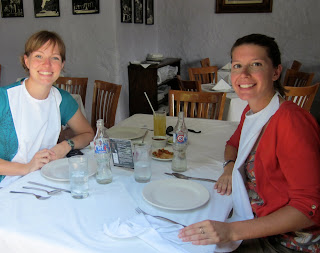Today was an intense day of discussions around three of my favorite topics: education, politics, and community.
Our day started with a lecture at the Center for Intercultural Encounters and Dialogue (CEDI)with Oliver Froehling. CEDI offers an alternative education for students. The school program focuses on meeting individual needs through apprenticeships and teaching students skills that they can take back to their communities and use. The reasons for the school: 1. Acknowledgement that traditional education has often tried to force assimilation. 2. There is not an economic stability to provide jobs for graduates of traditional school in Mexico.
Our discussion also focused on the indigenous communities throughout Oaxaca and the political and educational systems within those communities. The way that the word “community” is used for many of the municipalities throughout Oaxaca has a much larger meaning than when the word is often used in America. For example, the fiesta is all about reciprocity and solidarity. When somebody has a celebration, people contribute to the celebration and it is known that the contributions will be reciprocated in the future. The power of the communities as groups allows the indigenous communities to put pressure on political groups. The strength of community seems to be part of identity in this state, the site of the 2006 teachers union protests that lasted from June until November.
The discussion exemplified several questions that I often have about education.
What questions do I have?
In what ways might federalized education damage communities? Is the system of education at CEDI a more realistic ideology of education for students in the U.S., as well? What are we preparing students for? Are we preparing students for livelihood, critical thinking, a job market that may not exist? (Calm down, Rollag, I know.) Where does creativity fit into all of this?
Stop 2 for the Day: The Market. Yes! I went ahead and ate from vendors.
Stop 3: Our group went to Olllin Tlahtoalli Language and Culture Center to learn about a program in indigenous communities throughout Oaxaca. The program uses art and media narrative to give students a chance to tell their stories and connect with their history.
What connections did I make?
This stop was a little emotional for me as we heard students telling stories that are similar to stories of some of my own students. A video showed two students who were born in America, but their parents were at risk for being deported, so the entire family moved back to Mexico. Now, the students talked about the struggle of not fitting into the schools in Mexico. They were considered outsiders in the US and are now considered outsiders in Mexico. They plan to go back to the US and live with an aunt so that they can continue their American education. Their parents are torn between wanting to be with their children and wanting to give them what they believe is the best opportunities. Ugh.
In addition, I connected to the ways that the students told their stories through paintings. Working with seventh graders means that I always get to hear students tell and sort out stories of their identity.
Letting Go - After an intense day, I joined some friends to take in Oaxaca. We stumbled upon a restaurant that featured local Oaxacan specialties of mole and cheese. From there, we headed to the Zocolo in time to catch an incredible light show projected on the side of the Cathedral with a music background. I felt incredibly fortunate.
 |
| Light Show on the side of the Basilica |


















































